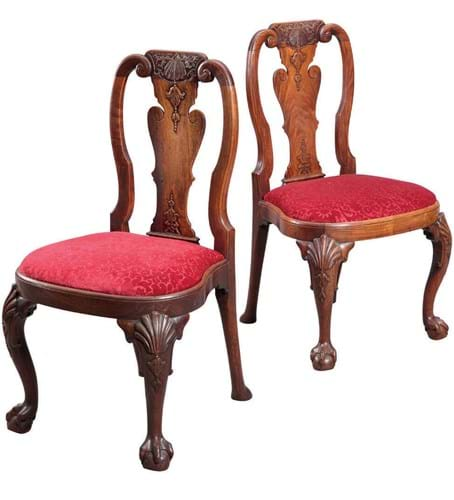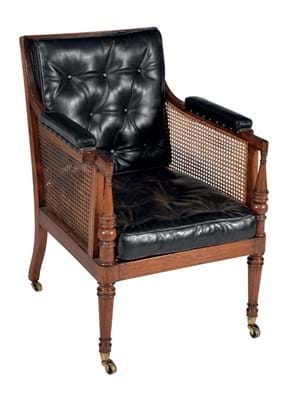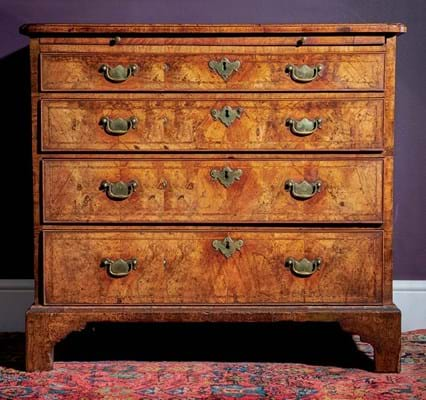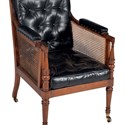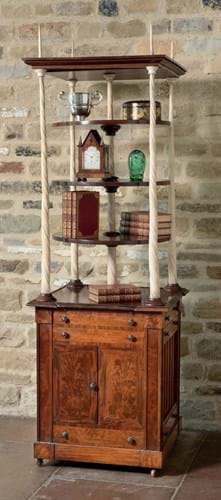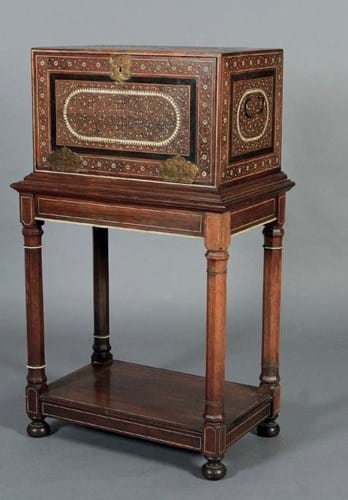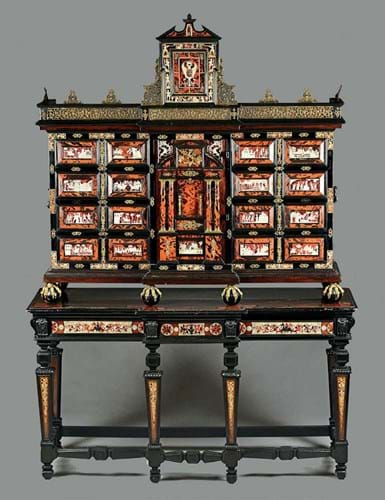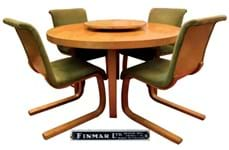One of the brightest examples combined classic early-18th century English design with foreign craftsmanship in the form of a pair of Chinese export padouk and huanghuali chairs.
Offered at Elstob & Elstob (20% buyer’s premium) in Bedale, North Yorkshire, on November 24, the 3ft 5in (1.04m) tall chairs were after a design by Giles Grendey (1693-1780).
London’s leading and richest, cabinetmaker in the first half of the 18th century, Grendey is also the best documented, which is why we know of his hard head for business and hard fists when bullying his apprentices.
But if Chinese craftsmen in the second quarter of the 18th century were to reproduce any maker’s designs, Grendey was the obvious choice. Probably working to a special commission, that they copied faithfully can be seen from this pair – although, as with classical Chinese furniture, they are constructed from joinery and doweling alone.
Very like Grendey’s chairs now in the Metropolitan Museum of Art in New York, each featured foliate carving to the crest rails and splats, and shaped drop-in seats, and were raised on cabriole legs carved with shells and pendant foliage, with ball and claw feet.
Minor condition problems were to be expected. A UK dealer beat rivals with a quadruple-estimate bid of £23,000.
English appeal
This May, Dreweatts (25% buyer’s premium) took £36,000 for a set of three similar Canton-made ‘Grendey’ chairs (ATG No 2394).
The furniture stars in the November 20 sale at the Newbury rooms were, however, strictly English, the best-seller being a c.1735 figured walnut and feather-banded ‘bachelor’ chest of drawers. It had a 2ft 7in x 19in (80 x 48cm) rectangular top with book matched veneer, and re-entrant corners and a brushing slide above four graduated drawers. It sold to a London private buyer on its lower £10,000 estimate.
Three Regency pieces could be confidently attributed to Gillows and dated c.1815.
One was a 3ft 1in high x 5ft wide (95cm x 1.58m) mahogany breakfront side cabinet. With a pierced gilt-metal, three-quarter gallery above the moulded frieze, it featured a central pair of panelled cupboard doors enclosing 16 solid mahogany drawers, flanked by panelled cupboard doors opening to five sliding trays.
Pitched at £3000-5000, it sold to the London trade at £7000.
Another was a rosewood library table. It had a 5ft wide x 3ft deep (1.53m x 92cm) shaped and moulded-edge top with a tooled leather inset above a pair of drawers and a pair of opposing drawers, above twin tablet-moulded supports and plinth bases decorated with reeded scroll terminals, on carved lion paw feet with carved shell terminals, on concealed castors.
Pitched at £2500-4000, it went to a UK private buyer at £7000.
The third was a pair of mahogany bergère library armchairs featuring rectangular backs, reed-moulded frames and conforming downswept arms, above turned tapering legs, brass caps and casters. The pair sold on the mid-estimate at £6500 to the dealer who bought the side cabinet.
While these three pieces got away above or around estimates, those who get moist eyes when talking of the good old days should probably skip the next paragraph.
A very closely related George II walnut chest of drawers took a premium-inclusive £20,000 at Christie’s in October 2012; in the same year a virtually identical Gillows library table made £18,750 at Sotheby’s and in 2002 a similar pair of caned library chairs took £47,000 at Sotheby’s Olympia.
Textbook desk
Leading the furniture at Lyon & Turnbull (25% buyer’s premium) on November 20 was a Victorian satinwood Carlton House desk with painted neoclassical decoration.
Once a market favourite, these desks, like almost everything else, have slipped a long way in price terms. The Edinburgh auction house, not known for unduly conservative estimates, pitched it at £2500-3500.
In its favour was a Harrod’s trade label and good overall condition, but what made the lot more unusual was the accompanying painted satinwood armchair. Standing 2ft 9in (84cm) high, it had a lattice splat and downscrolled arms above a caned seat and faux bamboo legs. Again it had some flakes and small losses and knocks commensurate with age, but nothing to deter bidders. The lot sold at £13,000.
Tusk force
Among the classic English pieces at Tennants’ (20% buyer’s premium) Leyburn sale on November 17 was a fine mid-18th century mahogany serpentine commode. Once a staple of upmarket furniture dealers’ stock, the 3ft 8in (1.11m) wide four-drawer chest, fitted with brass handles and pierced trellis backplate, went a shade below estimate at £5500.
Far more interest was predicted – and shown – in a one-off late 19th century construction. The mahogany upper cabinet featured shelves supported by four 4ft 2in (1.28m high) narwhal tusks to the corners and, through the centres, a fifth, 3ft 10in (1.17m) tusk.
The plainer, 2ft 8in (82cm) tall lower cabinet featured a ratchet writing surface to one of the two frieze drawers above upright dividers and a further long drawer flanked by two dummy drawers above cupboard doors. Last on the market in 1943, it came with a CITES non-transferable licence and sold to a UK private buyer just above estimate at £16,000.
Indian influence
Exoticism remains a great favourite at UK sales – as proved the case at Morphets (17.5% buyer’s premium) at Harrogate on November 28.
Catalogued as late-18th or early-19th century Anglo-Indian or Indo-Portuguese, a 21in (55cm) wide ebonised and ivory-inlaid cabinet, possibly from Gujarat or Sind, had a fall flap concealing an arrangement of drawers.
The cabinet was on a later stand, also strung with ivory. It sold for £13,000 against an estimate of £9000-12,000.
Cabinet position
The 1860-lot, four-day sale at Bellmans (22% buyer’s premium) was particularly notable for a number of high-priced clocks but included some solid-selling furniture and one star in particular.
This was a late 19th century south German rosewood and ebonised cabinet on stand. Standing 8ft 2in (2.48m) tall and mounted with gilt metal, ivory and tortoiseshell, the cabinet featured a pierced breakfront frieze over an arrangement of cushion-fronted drawers and cupboards and the stand had four frieze drawers on tapering square supports.
Pitched at £5000-8000, the piece attracted wide interest at the November 20 sale at Wisborough Green, West Sussex, before selling to a Continental buyer at £12,000.


